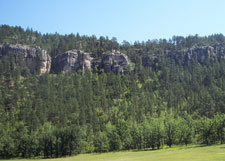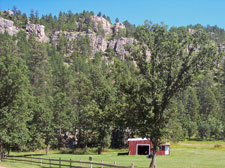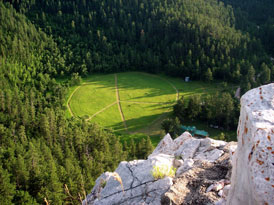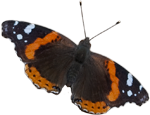
the stratobowl
NATURAL BEAUTY
The inhabitants. The Stratobowl is like a "mini national park". It has Spring Creek meandering through it and it is surrounded by high cliffs. Most importantly, it is a perfect environment for supporting an abundant population of natural creatures. It is a place where nature still has the upper hand - and, that's the way we plan to keep it.
Viewing the Stratobowl. By far, the best perspective for viewing the Stratobowl is from the rim overlook which is a short hike from a small trailhead off of Highway 16. The trailhead is 500 feet west of the Black Hills RV Center. From there, it's an easy 1/2 mile hike to the overlook. (photos by Terri Watson, Wim Bennik, Hank Fridell, Bill VanHuekelem)
A LITTLE HISTORY
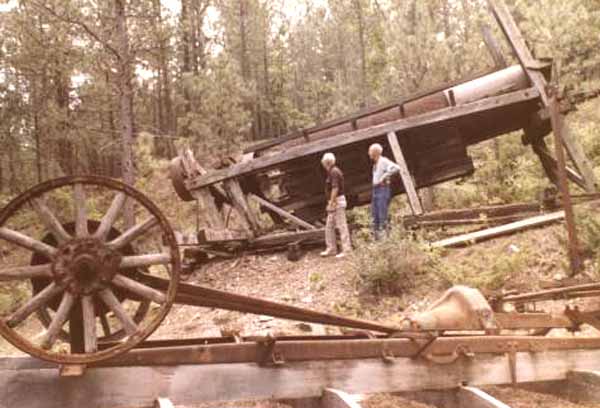
Placer Gold Mining. The Bonanza Bar Mining Company was organized in about 1890 to do placer mining on Spring Creek near Rockerville, SD. One of Company mines was on about 80 acres of property known as "Moonlight Valley" (later to become the "Stratobowl"). There, active mining took place from 1893 to 1905. Later, for a few years during the early 1930's, a few family members conducted placer mining operations on a small scale, but there was hardly enough gold produced to make a living. Now, the scattered "tailing" piles are all that remain of the old gold mining days.
Historic balloon flights. This is why the Stratobowl is "on the map". From here, in 1934 and 1935, the Army Air Corps and National Geographic Society launched manned balloon flights into the stratosphere to a record 72,395 feet. It was then that this little valley became known as the "Stratobowl" and the birthplace of the space age.
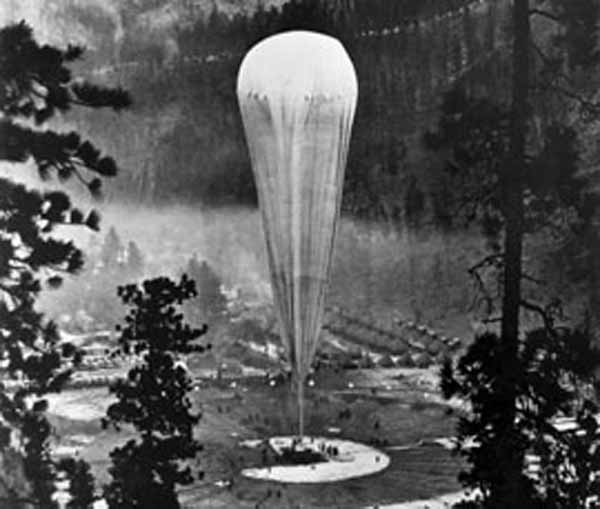 Much has been written about these historic flights since they were very significant, newsworthy events. The National Geographic documented them and there was a lot of media and newpaper coverage. You can easily find a great deal of information about the history of the Stratobowl by doing a web search and checking out any of the many excellent websites available, such as Morning Star Balloon Company and wikiepidia.com.
Much has been written about these historic flights since they were very significant, newsworthy events. The National Geographic documented them and there was a lot of media and newpaper coverage. You can easily find a great deal of information about the history of the Stratobowl by doing a web search and checking out any of the many excellent websites available, such as Morning Star Balloon Company and wikiepidia.com.
The Explorer II Gondola. The Smithsonion National Air and Space Museum in Washington DC is home to 1935 Explorer II gondola. Clearly, this underscores the historical significance of these flights - the beginning of the Space Age. To learn more, see the Smithsonion Museum site.
If you happen to be in the Black Hills area, there are two museums which have high quality displays about these flights. They are the South Dakota Air and Space Museum, which is located next to Ellsworth Air Force Base, in Box Elder, and The Journey Museum, which is near downtown Rapid City, SD.
TO BE THE FIRST TO FLY AROUND THE WORLD BY BALLOON
There have been two flights launched from the the Stratobowl which were attempts to be the first to fly "around the world" by balloon. In both cases, the pilots, who already held world records, flew very long distances, but failed to achieve success. They were great adventurers who didn't quit here. Sadly, all three pilots later died in aviation accidents. These flights were a part of the Stratobowl history and we have enormous respect for the pilots and their achievements.
The first flight was in November 1982 when Maxie Anderson and Don Ida gave it a try - Maxie Anderson (US Ballooning Hall of Fame). The pair made it to Ontario, Canada where they were forced to abandon the journey due to leaks in the balloon. (photos by Ken Tomovick)
The second was in November 1996, when Steve Fosset made his first "Round The World" attempt - Steve Fossett. He made it to St. John, Canada, approximately 2,200 statute miles. He did not win the competition to be first to fly around the world; but, in July 2002, on his sixth attempt, he succeeded in becoming the first solo balloonist to do so. (Steve Fosset photos from Rapid City Journal, January 1996)
back to top
HOT AIR BALLOONING
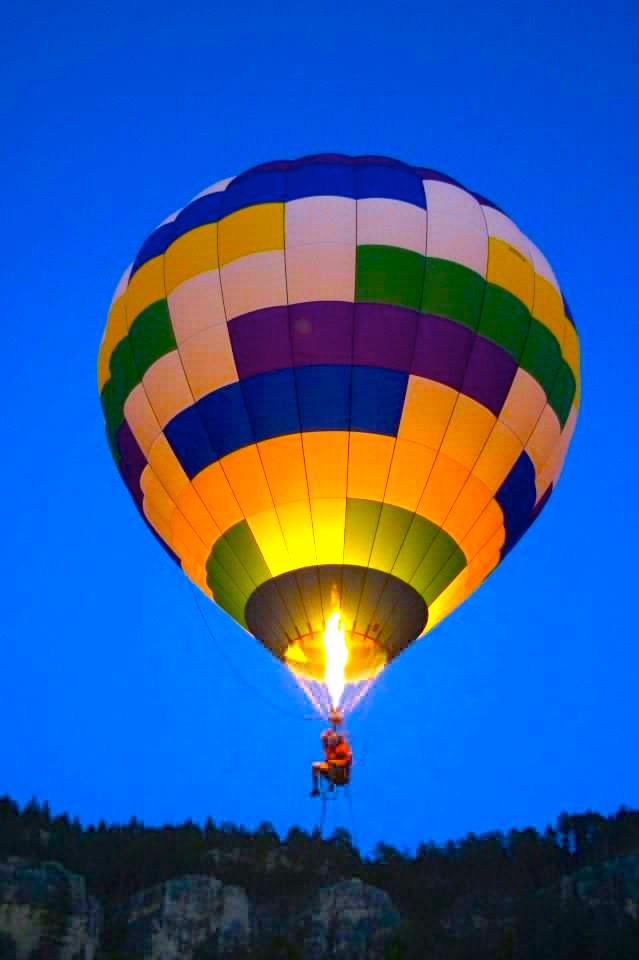
Scott Wooge's Hopper balloon. Photo by Kim Wooge
Hot Air Balloon rally. Every September, ten to twelve experienced balloonists gather to celibrate the anniversary of the historic 1935 balloon flight and, of course, to enjoy great ballooning. They come from around the nation for three days of challenging and beautiful flying over the Black Hills. Since the flights are conducted over mountainous terrain, this is considered "extreme" ballooning. The pilots, therefore, must not only be be very experienced, but they must possess specialized mountain flying skill.
Here is a nice article with some great photography, from the September 21, 2013 Rapid City Journal.
 There are usually some passenger rides made available for the public. James Loverich, a passenger who flew with pilot Heather Day said: "I can tell you that the experience is surreal. The lift off and ascent out of the Stratobowl with its surrounding high cliffs and rugged terrain provides an incredible view and an unforgetable thrill."
There are usually some passenger rides made available for the public. James Loverich, a passenger who flew with pilot Heather Day said: "I can tell you that the experience is surreal. The lift off and ascent out of the Stratobowl with its surrounding high cliffs and rugged terrain provides an incredible view and an unforgetable thrill."
Another passenger, Jay Davis, described his flight with pilots Damien Mahony and Keely Wade this way: "This was a dream of a lifetime to take a balloon ride over the Black Hills; and, to be able to do it from the Stratobowl was an unbelievable opportunity. The experience was really beautiful - so cool! My only complaint was that we didn't stay aloft longer". (click on photos to 'expand')
Pilot Kay West, of Sioux Falls, SD describes the pilot's perspective: "Seems like everyone has a bucket list these days and one of the most popular items on that list is a hot air balloon ride. For many lighter-than-air pilots, flying a balloon from the Stratobowl is high on their list. The aviation history alone is enough to lure one into the bowl, add to that the beauty of the Black Hills and the excitement of mountain flying makes this a very special event. With 400 feet from the floor to the rim, the lift-off is spectacular as we slowly ascend with the canyon rock walls as a backdrop. If the winds are just right, the balloon drifts down Spring Creek canyon through a wilderness area where the creek actually disappears underground. By working the winds just right, you can drop into the canyon and follow the flow until it empties out near Reptile Gardens."
Ballooning photos....
back to top








